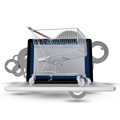For every business, whether product or service-based you will find countless websites, each claiming to be unique and offering their own value propositions. Over the years, online shopping has evolved dramatically, shaped by fierce competition, changing customer preferences, and shorter attention spans.
Think about the empty retail stores you must have come across and wondered how they manage to cover rent, salaries, and other expenses. The reality is, many of them don't! They struggle to break even and often shut down. The same harsh truth applies to e-commerce websites. A large number of these sites fail to stand out, perform below average, and eventually fade into obscurity. To thrive, businesses must go beyond the ordinary and unlock the strategies that drive conversions and long-term success.
Why Conversion Rates Matter More Than Ever
The digital marketplace today is undoubtedly competitive, and gaining organic traffic to an ecommerce website is just half the battle won. The main challenge lies in converting visitors into loyal customers, who keep coming back when new products are launched. It can get quite frustrating when the conversion rates are low, and this is why every click on your website counts. When the conversion rates are high, you not just see a boost in the revenue but also reduce the CAC (customer acquisition costs). This maximizes the returns obtained on the investment you have made on marketing your brand.
Also, when customers have endless products at their fingertips, a conversion-focused ecommerce website stands out from the rest. Every second the ecommerce website takes to load is the wall between your customers and the sales. This increases the potential risk of losing a sale, thus reducing conversion rate.
So, if you as an ecommerce brand wish to succeed in today's digital landscape, you certainly need to consider optimizing your website to improve conversions.
The Gap between Average and High-Performing E-Commerce Sites
Have you ever wondered why one ecommerce store performs better than the other? Well, the secret to this lies in the minute details, which most of us often ignore. High converting ecommerce websites prioritize user experiences, and focus on intuitive navigation, page load speeds and clear CTAs. Most of these websites are also data driven, and brands also test all the elements on their website including the checkout flow or the product descriptions.
Ecommerce brands also overlook a few critical aspects like complicated checkouts, cluttered website layout or design, or random CTAs. Such aspects can result in cart abandonment and make your visitors frustrated. In worst cases, a few of them might not want to visit your store again.
High performing ecommerce websites understand their audience, and they personalize the visitor's experience. The secret sauce here is in the design, the functionality and the message - all of which are personalised as per the user.
II. User Experience (UX) Design Fundamentals
If you are planning to create a high performing ecommerce website, one of your main focus needs to be on user interface. Irrespective of how good the products are, if the website is confusing or slow, it will drive the customers away.
A. Intuitive Navigation
The website's navigation is more like a virtual map. If the navigation is confusing, the users might feel lost and they will just leave the website. This is what makes it important to focus on creating an intuitive navigation for your ecommerce website.
- Simplified Site Architecture - Start by categorizing the products logically, and the structure will automatically flow. Make sure that the website has a simple layout so that the visitors can find what they need easily.
- Intelligent Search Functionality - The search function on your website is a very powerful tool, which can act as a personal shopping guide to the visitors. Enable auto complete feature, misspell suggestions and advanced filters to improve the overall experience.
- Minimal Click Path To Purchase - The path from product page to the checkout should be shorter. Check the flow and remove unnecessary steps or pages and provide an option of guest checkout for unregistered users.
- Mobile First Design Principles - Users use mobile devices to make purchases, and hence implement a mobile-first design for your ecommerce store. Make sure it loads quickly and scales well on all screens. Also pay attention to navigation and ensure it is thumb-friendly.
Remember to design the online stores with the user experience in mind, and use the power of hassle-free navigation to your advantage.
B. Page Load Speed Optimization
Speed is everything if you wish to achieve success in the world of online shopping. Let us have a look at a few key elements related to page load speed optimization.
Critical Performance Metrics - It is important to focus on the right metrics if you wish to optimize the page load speed. Some of the critical metrics to be considered are,
- FCP or First Contentful Paint
- LCP or Largest Contentful Paint
- TTI or Time to Interactive
Impact Of Milliseconds On Conversion Rates - If your website loads even a millisecond longer it can drastically reduce the conversion rates. Though it might not sound much, the impact can be seen overtime, and cart abandonment issues become quite common.
Technical Optimization Strategies - Technical optimization can improve your site's speed drastically and these include,
- Image optimization
- Enabling browser caching
- Minifying the code
- Using a CND ( Content Delivery Network)
Lightweight Design Techniques - The overall design of your website has an impact on its performance. Ensure your ecommerce website has a minimal and light weight design as it not just looks aesthetic but improves the page load time as well. Also, avoid overloading pages with large videos, excessive animations, or bulky fonts. Audit and remove unnecessary ones regularly.
C. Psychological Design Elements
Your e-commerce website isn't just about products and prices—it's about how it makes customers feel. By understanding how colours, emotions, and visual cues influence decision-making, you can create a site that not only looks great but also converts. Let's explore some key psychological design elements that can take your e-commerce game to the next level.
- Colour Psychology In Ecommerce - Colours do more than just make your site visually appealing—they play a huge role in influencing customer behaviour. For example Green signifies action, positivity, and progress. It's a great colour for “Buy Now” buttons or eco-friendly product lines. You can thus choose the colours that resonate with your visitors and your brand to improve conversions.
- Trust Building Visual Cues - Trust is a cornerstone of e-commerce success. You can display security badges like SSL certifications, “Secure Checkout” icons, or payment method logos (like Visa, PayPal) on key pages. Add genuine reviews and use high-quality, realistic product images make your brand appear reliable and premium. Avoid overly edited or stock-like images that may feel fake.
- Emotional Design Principles - The right design helps a brand connect with well with the target audience. Brands can use visuals and text to tell your brand story. For example, showing a behind-the-scenes video of how your products are made can create an emotional connection. Other examples include using relatable realistic images and FOMO principle to drive sales.
- Reducing Cognitive Load - Cognitive load refers to the effort requited by a visitors to process the information listed on your website. Hence having a simple layout, and easy navigation can drive conversions. Brands can also use clear CTAs and keep use a minimal and clean design without too many pop-ups or animations.
III. Personalization Strategies
The ecommerce landscape is quite competitive today, hence personalization of the website as per your brand is important. By doing so, brands can increase their conversion rates, improving orders.
Let us have a look at a few personalization techniques that can positively impact your ecommerce business.
AI-Driven Personalization - AI is now used by many businesses around the globe to interact with their target audience. Making use of real-time data like user behaviour and analysing the same can help in creating relevant shopping experiences. There are a few ways in which AI can be used to redefine how a customer shops on your ecommerce store, and a few of them are,
- Real time product recommendations via options like “you may like” or “similar products”.
- Using past behaviours to predict shopping experiences.
- Using dynamic content to personalize the website experience for every customer.
Customer Segmentation - We know that not all customers are the same, so why use the same experience for every visitor. Brands can create tailored experiences for specific grounds, which helps maximize engagement as well as relevance. Some of the methods include,
- Use of advanced segmentation methods which are beyond location or age.
- Create customised journeys for users as they will feel valued as well as engaged throughout the shopping process.
- Create marketing messages that resonate with how users interact on the site.
- Make good use of micro-moment marketing to gain sales via impulsive buying.
IV. Conversion Optimization Techniques
If you as a brand are trying hard to convert your visitors to loyal customers, you need a strategic and thoughtful approach. Conversion optimization techniques which can be implemented in no time include reduction of barriers and building brand trust. Let's see how it can be done.
- Checkout Process Design - Checkout is the final step and can termed as a crucial one too. You can start by simplifying and refining the checkout process, as having a smooth, secured and friendly design makes a lot of difference. Ask only for needed information as it prevents abandonment. You can also implement purchasing with just one click to drive sales. Provide different payment options that can cater to the preferences of difference customers.
- Social Proof and Trust Signals - If you want to convert any hesitant visitors to customers, you need to start building trust, and this can be done via social media. Authenticity matters, so don't shy away from integrating user-generated content like photos, videos, or heartfelt testimonials from real customers as these add a personal touch that builds credibility.
- Pricing and Promotional Strategies - Smart pricing and well-thought-out promotions can work wonders in driving purchases while keeping profitability intact. Start by using dynamic pricing models that adjust in real-time. You can use psychological pricing techniques as they when done right can prove to be a game changer.
V. Technical Performance Optimization
It is no surprise that a good ecommerce website has a great technical foundation. By optimizing performance, you can ensure your website not just operates smoothly but can help fine-tune the overall user experience.
Mobile Responsiveness - Majority of shoppers use smartphones to shop online, and this makes it necessary to have a mobile-optimized ecommerce website. A responsive website not just improves usability but is also helpful for SEO. You can make use of Progressive Web App technologies to provide the users with the best of mobile apps and website. Pay attention to adaptive designs and high performance across all devices.
Advanced Analytics and Tracking - Brands can make use of data to take decisions related to optimizing the website's performance and conversions. Some of the tools that can be of help include,
- Predictive Conversion Modelling
- User Behaviour Heat Mapping
- Advanced A/B Testing Methodologies
- Real-Time Performance Monitoring
VI. Emerging Conversion Technologies
The future of e-commerce is changing, and as technologies grow, the ways that companies interact with consumers and lead them to purchase are changing as well. There are two relative technologies, namely, Augmented Reality (AR) and Conversational Commerce, which have recently emerged as industry trends.
Integration of Augmented Reality
AR is a revolution for the way people shop on the Internet, it blurs the line between online and real life shopping.
- Virtual Product Try-Ons - AR users can also experiment with some products, such as clothing, makeup, or even home furniture without actually purchasing them.
- 3D Product Visualization - A shopper gets a 360 degree view of the product and the real life size of the product, its texture even the details are well depicted.
- Interactive Product Experiences - Using an AR application like placing virtual products in a room are helpful to the customer thus increasing confidence for the customer.
- Reducing Purchase Hesitation - With regards to fit, size or look, the constant doubts eliminated through AR result in much higher conversion rates.
B. Conversational Commerce
This is a new way of communication between businesses and customers that is rapidly evolving and is changing the way they interact.
- AI-Powered Chatbots - AI capabilities of chatbots include the ability to offer around the clock support for customers answering questions, leading the user through the purchasing process and even recommending products based on user's personal preferences.
- Voice Commerce Integration - There's a step-up of voice-activated shopping through smart devices such as Alexa or Google Home that makes it easy for consumers with such devices to shop for their products without making physical efforts.
- Personalized Shopping Assistants - Such AI tools adapt to user preferences and shopping becomes as personalized as one would expect from a human approach.
- Natural Language Interaction - Natural language interfaces allow customers to interact with automated systems in a familiar manner, satisfy customers and increase sales.
VII. Customer Trust and Security
In e-commerce, trust and security are considered as one of the main significant indicators. Customers have to be sure their information is secure, as well as they should know support is provided in case of any emergency.
Transparent Security Measures
Creating a secure shopping environment ensures consumers are allowed to shop confidently and plan to shop with the brand again.
- Advanced Data Protection - Use the best methods in protecting customers' data through the use of encryption, firewalls and standards measures.
- Visible Security Certifications - People can trust an organization through certification such as SSL, PCI compliance, or a label implying security at checkout.
- Privacy-First Design - Continue to improve and state your privacy policies where possible and enable the users to decide on their data insights.
- Ethical Data Usage - Do not gather too much information and use customer's data in a proper way that can benefit the longevity of the relations.
B. Seamless Customer Support
Proving efficient customer support can build trust and loyalty in customers and can even convert a negative experience into a positive one.
- Multichannel Support Strategies - Provide customers with an opportunity to get support through live chat, email, social media, or phone call.
- AI-Enhanced Support Systems - Brands can also use AI for handling frequently asked questions or as a preliminary step to refer the customers to the human agents to resolve the case as soon as possible.
- Proactive Problem Resolution - Brands should also be on the lookout for possible problems (such as a slow delivery) before a customer brings it to the company's attention.
- Emotional Intelligence in Customer Service - Teach your staff to relate to customers, make them feel unique, and provide an outstanding support service.
VIII. Content Strategy for Conversion
Brands can make use of a planned and strong content strategy that highly influences the buying decisions of the customers.
A. Compelling Product Storytelling
Emotions play a very important role in the purchase decisions of customers; therefore, stories become very popular.
- Emotional Product Narratives - Describe the processes of creating products, people behind them, or how useful products affected people's lives.
- Authentic Brand Communication - Use the right tone of voice, which would be in line with your brand's core values and relay a message which is more agreeable to the targeted population.
- Visual Storytelling Techniques - Opt for pictures, videos and other graphic formats to explain how your product works to the client.
- Value-Driven Content Marketing - Talk about how valuable the products you sell are to the customers and how they have impacted their lives.
B. Interactive Product Descriptions
Gone are the days when brands used static text on their website. Interactive content can be used for user engagement and increase conversions.
- Multimedia Product Presentations - Ensure you add more visibility to your product pages by adding videos, 360 degrees view, and animated GIFs.
- User-Generated Content Integration - Try and incorporate the photos or videos of your happy customers within the product pages to enhance their credibility.
- Contextual Product Information - Include information that may be asked, for example, size charts, washing care instructions or information for the necessary products.
- Sensory-Rich Descriptions - Be specific and appeal to the senses of the users so they can in their mind's eye feel the texture and smell and see how the product is integrated into their life.
IX. Retention and Post-Purchase Experience
Remember that the journey of a customer does not end when he or she checks out. Businesses need to retain customers to keep those sales ticking. This is why creating a good post-purchase experience is quite necessary.
A. Customer Loyalty Mechanisms
Brands can build loyalty via planned customer engagement, quality products, discounts and rewards.
- Personalized Retention Strategies - Send customer's emails about a special offer or promos that makes them feel valued or even a birthday discount.
- Predictive Repurchase Modelling - Automatically suggest when customers may need to restock or rebuy an item and send reminders or related promotions via an email or message.
- Gamification of Shopping Experience - Brands can make shopping engaging and fun via points, challenges or even badges if they are related to the brand.
- Emotional Customer Relationship Management - It is crucial to develop the employee's emotional connections through skills like delivering excellent consumer service, appreciation, and making the customer feel that they mean a lot to the brand.
B. Seamless Omnichannel Experience
Brands need to remember that customers look forward to a unified experience across all touch points.
- Integration Across Platforms - Make sure that all (online & offline) channels (like website, app, and physical stores) work perfectly together.
- Consistent Brand Experience - Be consistent with the branding across all platforms as it builds trust as well as loyalty.
- Unified Customer Journey - Let customers begin shopping or browsing on one device or platform and allow the journey to continue on another without losing their progress.
- Cross-Device Functionality - Offer a great customer experience when the customers switch between devices through their shopping journey.
X. Future Trends and Predictions
Ecommerce as a landscape has been changing rapidly. So, if you as a brand wants to thrive and stay ahead of your competitors, you certainly need to focus and go with the trends.
- Emerging Technologies in E-Commerce - AR is assumed to grow further, as well as AI, blockchain, and the metaverse enabling enriched more individualized shopping.
- Shift in Consumer Behaviour - Consumers are increasingly prioritizing convenience, personalization, and sustainability. Businesses that align with values like the above will certainly gain an edge.
- Ethical Considerations in Digital Commerce - Transparency in sourcing, ethical data practices, and sustainable packaging will become critical to earning customer loyalty.
Preparing for Future Market Changes - Stay agile by investing in scalable technology, monitoring market trends, and adapting your strategies to meet evolving consumer needs.
XI. Conclusion
Successful e-commerce conversion rate optimization is a process that can be based on technology, design, strategy and, most importantly, customer needs. But it's not always about having the coolest gadgets around, or the most outstanding features of the product; it is about making shopping an experience that a typical consumer would want to undertake because the products being marketed are good enough to warrant the investment.
The main thing is to combine the results of operational technological thinking with the human approach. Even concepts like AI, AR, and analytics may help change how brands and customers engage, but they should only amplify, not diminish, the relationships a brand creates. Marketing tools like empathy, clarity, and passion will stay the most valuable in building meaningful relationships with your customers.
Now is the best moment to move forward. Review your website, apply all the changes explained in the article and use the metrics to make more wise decisions. By focusing and committing enough together with the aptitude of the corporate to place the customer first, your e-commerce business is poised to not only survive, but thrive in this fast evolving digital world. The brands, which can grow, are those that are ready to take risks, change, and make the customer the focal point of their business.



















 Ecommerce Website Development In Delhi
Ecommerce Website Development In Delhi  Ecommerce Website Development in Jaipur
Ecommerce Website Development in Jaipur  Ecommerce Website Development in Ahmedabad
Ecommerce Website Development in Ahmedabad  Ecommerce Website Development in Bangalore
Ecommerce Website Development in Bangalore  Ecommerce Website Development in Chennai
Ecommerce Website Development in Chennai  Ecommerce Website Development in kolkata
Ecommerce Website Development in kolkata  Ecommerce Website Development in Gurgaon
Ecommerce Website Development in Gurgaon  Ecommerce Website Development in Mumbai
Ecommerce Website Development in Mumbai  Ecommerce website development in India
Ecommerce website development in India 




